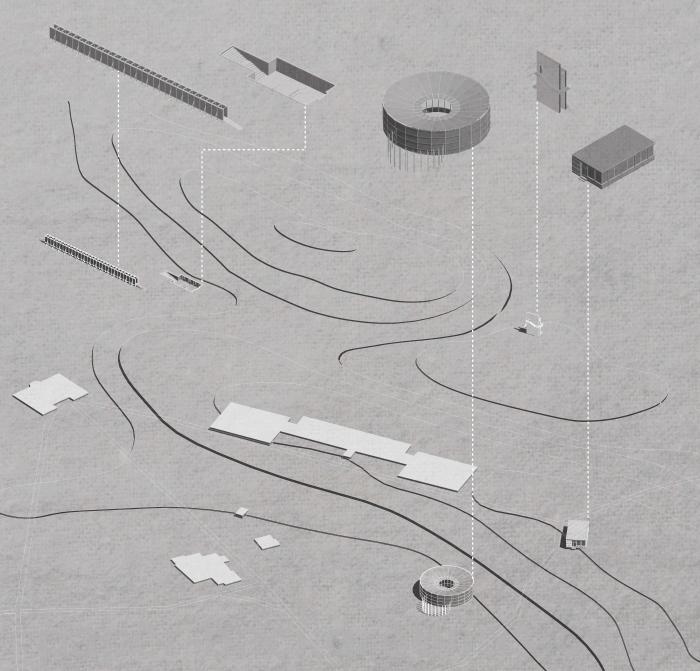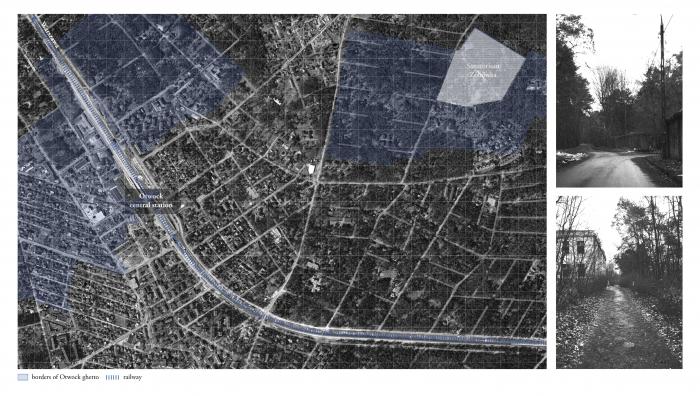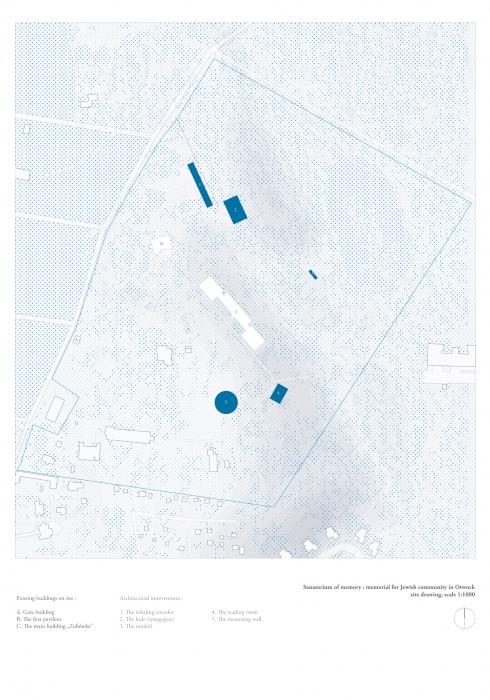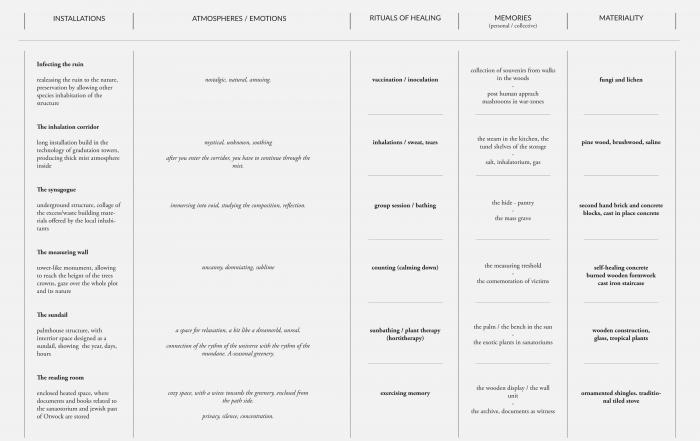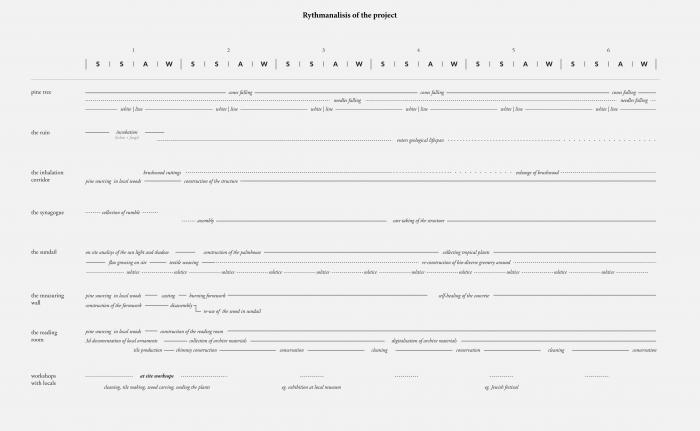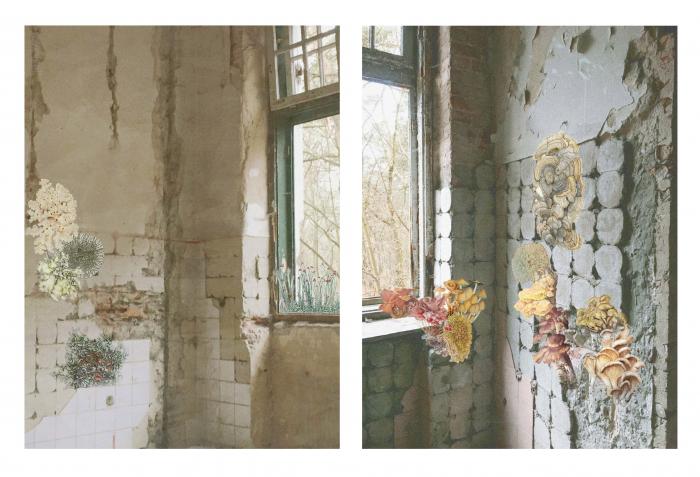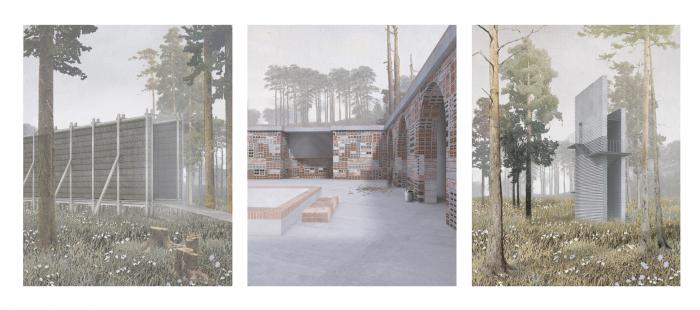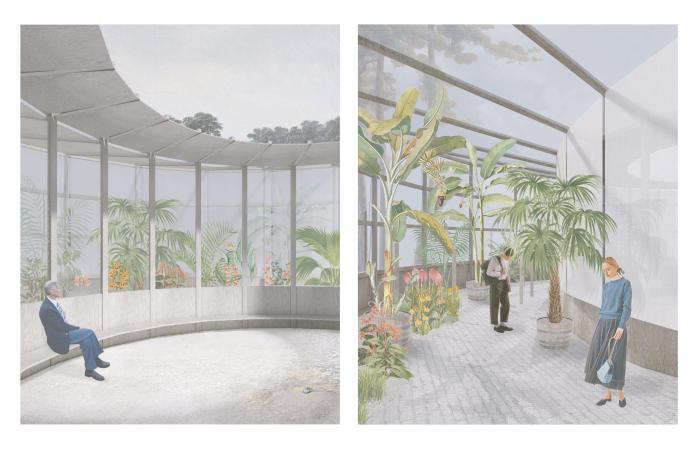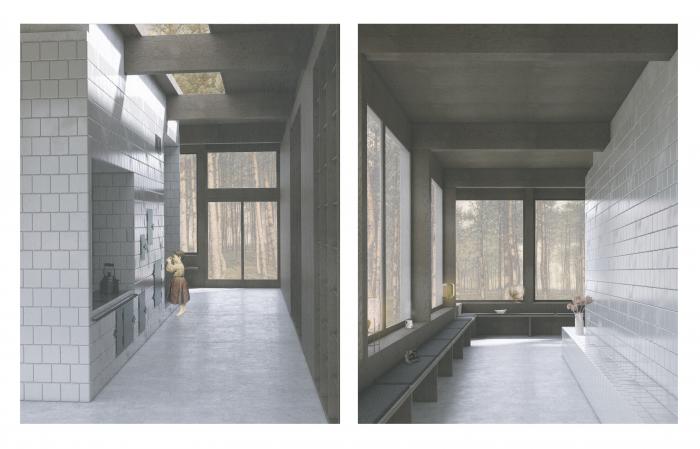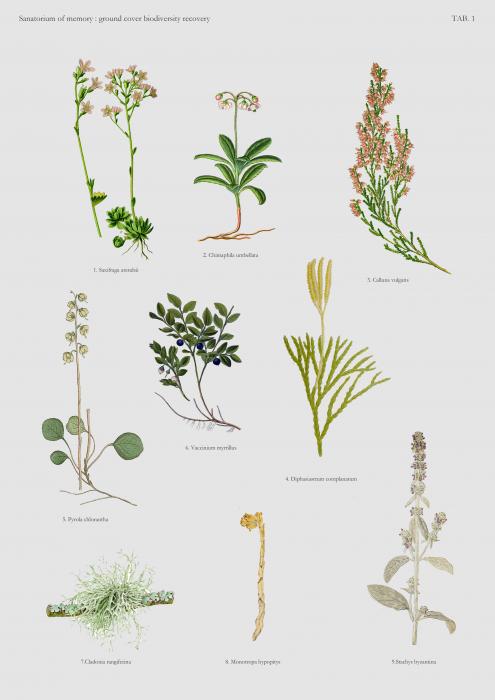I. SUMMARY INFORMATION
Project
269404
Status
Submitted
Award category
Preserved and transformed cultural heritage
You want to submit
NEW EUROPEAN BAUHAUS RISING STARS : concepts or ideas submitted by young talents (aged 30 or less)
Project title
Sanatorium of memory
Full concept/idea title
Sanatorium of memory: memorial for Jewish community in Otwock
Description
The project explores the link between architecture and memory. It is a set of architectural interventions, surrounding the ruins of a previous sanatorium for mentally ill Jews in Otwock. The project aims to rehabilitate the absent memory of the exterminated pre-war community, among the present inhabitants of the city, with the use of means of architecture. While seeking inspiration in the vernacular heritage of the city, it explores various ways to preserve the memory: personal and collective.
Where is your concept/idea being developed or intended to be implemented in the EU?
Poland
Masovia
Jana Kochanowskiego 10/16
52°06'51.5"N
21°17'21.3"E
Otwock
05-400
II. DESCRIPTION OF THE PROJECT
Please provide a summary of your concept/ idea
In the 1925 guidebook to “Otwock Resort”, we can find a description of the newly established city-sanatorium as a place where nature coexists with the modern man. Otwock was at that time the first in Poland located on the lowlands tuberculosis resort, which was characterised by unique air conditions and well prospering modern guest houses. As Beatrice Colomina suggests, sanatoriums might have been what has made architecture in the 20th-century modern, by introducing new typologies of buildings and technical improvements into the daily lives of their users.
The majority of buildings in Otwock were wooden villas built in a local style called Świdermajer. They had big porches, where patients could sunbathe and inhale the fresh air in a horizontal position. Many of them have been run by Jewish citizens, who in the years before the II WW made up to 60% of the city's inhabitants. Today most of these houses have vanished or are decaying, along with the city's natural assets being destroyed by pollution. Not only is natural and architectural heritage in Otwock endangered, but also the memory of its pre-war Jewish community and the broad understanding of local history.
The project of the memorial for the pre-war community in Otwock aims to rehabilitate the fragmented memory of the pre-war community. Its architecture is inspired by rituals and materiality connected with processes of healing, as a medium that due to the strict connection with body and atmospheres, might enable users to create new memories of the place. All installations follow the same criteria: they are made out of local materials, aim to create a multi-sensual atmosphere, provoke movement or reflection upon known spaces. Taking into advantage that the architectural project is not a static object, but a choreography of changes in time, I focused on the processes bound with the creation of the structures as well as their preservation and their performance in the future. https://adkworks.photo.blog/473-2/
Please give information about the key objectives of your concept/idea in terms of sustainability and how these would be met
„Contemporary ruinophilia relates to the prospective dimension of nostalgia, the type of nostalgia that is reflective rather than restorative and dreams of the potential futures rather than imaginary pasts” claims Svetlana Boym. Restoration and preservation of existing structures are two ways to reduce the impact of the production of architecture on the environment. But the reduced environmental impact of such solutions is not their only advantage. By preserving the heritage we also give testimony to the life and production of spaces of the past societies. By preserving architecture, we preserve the memory and contribute to the creation of the local identity based on a broad and inclusive understanding of its history.
Constraints of sustainability are reached in the project by the preservation of the ruins of the neglected Jewish sanatorium, and the surrounding forest, but also by the conscious choice of materials that the new installations are made of. The main construction material for the new structures is the local pine, used in a way that reduces the waste from its production. Pine needles, oils and small branches and other by-products of logging are used to produce materials for furniture or interior finishes. The rest of the materials used for the structures are either produced or sourced locally, reducing the impact of the project on the natural environment as well as contributing to the local economy.
Regarding the preservation of the natural heritage, the project aims to re-establish the biodiverse nature on the site that has been ruined by the pollution caused by the inhabitants of the city, who use the forests as a landfill. Similarly, like the forest, the ruin is being rehabilitated in the process of giving it away to endangered species. I propose to infect the ruin with fungi and lichen, for them to become its new inhabitants and help it immerse even more into the surrounding nature, completing the life cycle of its existence in this place.
Please give information about the key objectives of your concept/idea in terms of aesthetics and quality of experience beyond functionality and how these would be met
The design proposal consists of 6 interventions that are each related to the two main themes of the project: rituals of healing (as a link to the concept of sanatorium and healing as a metaphor for preservation), and memory – the personal and collective, intertwining.
In the project, I have focused on enhancing the poetic qualities of the space around the ruin, to create an atmosphere of reflection and silence, that the commemoration of Holocaust requires. The arrangement of the structures on the site enhances the visitors of the memorial, to wander in the greenery, and explore the place at their own pace. The narrations behind each of the installations are open-ended. Their functions, shapes and materials have been inspired by spaces I have known from my grandmother's house also located in Otwock. In this way, the design proposal both addresses the personal and collective memory of the city. The personal memory of my grandmother's house, and the collective memory of the city, represented by the archive materials analyzed in the research phase of the project. By combining the two perspectives, highly personal and the historical one, I hoped to achieve a multifaceted composition of spaces with ambiguous meaning. All installations have been designed to create a multi-sensual experience, to engage with the user’s memories of the past and leave a lasting mark of their visit.
Some of the installations re-discover the spatial themes and building techniques characteristics for the Świdermajer architecture. Some on the other hand, reflect upon the processes that one can observe in the contemporary city of Otwock, such as multiple fires that destroy the local wooden heritage or the rubble waste connected with the contemporary architectural production in the city. Some create links to the typical elements of vernacular Polish architecture, by rediscovering the production techniques that they have used and by trying to recreate the lost atmospheres from the past.
Please give information about the key objectives of your concept/idea in terms of inclusion and how these would be been met
The project approaches the topic of inclusion in three ways that complement each other. The first theme connected with inclusiveness is related to the new function of the site. The project aims to create a space, where the story of the “others” is being told. The Jewish community in Otwock has been forgotten for almost 50 years after the war, due to post-traumatic loss of memory. Today it is still very fragmentary, and from 44 memorial sites in the city, there is only one dedicated to the Jewish community that in the years before the war made up to ⅔ of the city's population. I believe that for the current inhabitants of the city to understand their local identity fully, it is crucial to bring these forgotten parts of cities' history back. In this way, the memorial also becomes a place, where one can reflect upon lessons from the past and aim to create more inclusive futures.
The second layer of inclusiveness relates to the aim to rebuild the biodiversity on the site. The proposal for the preservation of the ruin represents the post-human approach, as the ruin is being given away to fungi and lichen. The ruins also are known to be places, where due to high humidity and good substrate material many endangered species find shelter. In this project I take advantage of this natural quality of space, to underline that to create inclusive spaces, we cannot exclude nature's needs and we need to see biodiversity as one of our main future objectives while engaging with historical architecture.
The last aspect of inclusion relates to community work, and its possibility to create tight relationships between inhabitants of cities. It is represented in the project by the inclusion of the inhabitants in the process of building. Some of the elements such as stove tiles, shingles and other details would be produced during workshops. It is a very important element of the process as it is the local inhabitants who will give value and significance to this place.
Please explain the innovative character of your concept/ idea
In my project, I question the common approach to memorials as designed for eternity. I believe that to effectively preserve memory, one has to exercise it. Therefore in this project I propose a set of installations that deal with processes in time, some are ephemeral - made to disappear, some are cyclical, retained by preservation or maintenance of the structure. Some, like the existing ruin, are also eternal, made to last.
The project has been based on a deep analysis of the contemporary approaches to the idea of preservation as an active strategy rather than a post factum action. Each installation has been designed in a way that bonds the processes of its production with the processes of its future preservation. That way creating a transparent link between the past and the future. The preservation actions that have to be conducted on the memorial site have been choreographed in a way, that the community can engage on different levels with the structures every year, at the same time due to the cyclical nature of these processes, architecture becomes also a reference point to the changes that occur in the surrounding forest.
The project aims to enhance the connection of the users with the past, the beauty of the natural forest and help them understand the primary “locus” of the place. The metaphorical healing happens as a communal experience, of being in this particular place, and appreciating the lost silence. The aim of the project is to help users re-establish their connection with nature and the lost spirituality, seen in the link with local traditions and respect to the natural environment.
Please detail the plans you have for the further development, promotion and/or implementation of your concept/idea, with a particular attention to the initiatives to be taken before May 2022
The project of the memorial was conducted as a part of a master thesis defended in June 2020 at the Royal Danish Academy of Fine Arts. Since then the project has been continued in two ways. As a research project, called “Healing Otwock” developed as a part of the Exercising Modernity Academy organized by Pilecki Institute in Berlin, where I continue studying the city's past and ways in which the city could develop in the future with respect to the existing overlooked heritage.
The second one is a project of an art festival commemorating the Jewish community, called “Festiwal Otwock Letnisko /Otwock Resort Festival” planned for August 2022 on the 80th anniversary of the annihilation of Otwock ghetto. Until the end of year 2021 the festival team will focus on creating the website and social media promotion campaign for the project. In early 2022 five young artists will be invited to the city of Otwock for a week-long workshop where they will be introduced to the sites of the festival, and from that point on they will start work on 5 works of art in public space that will be presented during the festival in August 2022.
The new artworks and the festival will focus on the life and cultural contribution of members of the Jewish community in Otwock that was responsible for the city's popularity in the years before the II World War. The documentation of the events of the festival and singular artworks will be presented on the website among other archive materials. This way, the festival's website will gather in one place, the fragmented memory about the past community.
Depending on the festival’s popularity in the future the temporary artistic actions could result in more permanent improvements and investments in the city. Investments such as the proposed memorial I have designed for my master thesis. First though, the absent memory has to be rebuilt in the community, so the future memorial site gains recognition and acceptance among the locals.
III. UPLOAD PICTURES
IV. VALIDATION
By ticking this box, you declare that all the information provided in this form is factually correct, that the proposed concept/idea has not been proposed for the New European Bauhaus Rising Stars Awards more than once in the same category.
Yes
